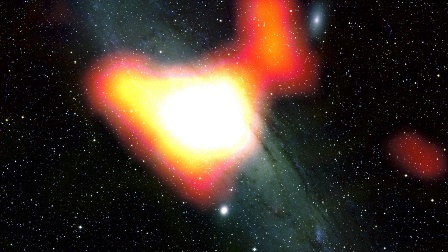A recent research could possibly indicate mysterious dark matter in neighboring Andromeda galaxy (M31). The research was led by Dr. HOU Xian, a scientist at Yunnan Observatories (YNAO), Chinese Academy of Sciences (CAS) and her coworker Pierrick Martin, France. The related work, financially supported by National Natural Science Foundation of China, was published on the The Astrophysical Journal.
As the highest-energy form of light, gamma rays are often produced by the most energetic phenomena in the universe. The Milky Way (MW) is shinning in gamma rays which predominantly originate from interactions between cosmic rays (CRs), particles traveling near the speed of light, and the interstellar medium (ISM). Such an emission correlates with regions rich in gas or star formation activities and fills most of the disk of the Milky Way from the center to the outskirts of the galaxy.
Surprisingly, a recent analysis performed by the Fermi Large Area Telescope (Fermi LAT) collaboration shows that the Andromeda galaxy, also known as M31, produces gamma rays in a region confined to the innermost central parts of the galaxy rather than filling the disk of the galaxy or extending far above or below it. In this case, the gamma-ray emission from M31 cannot easily be interpreted as CRs interacting with gas in the ISM. Scientists are proposing other mechanisms or scenarios to account for the observed unusual spatial distribution. Interestingly, the gamma-ray signal from M31 is similar to the one Fermi has detected at the center of the MW.
One possibility is dark matter, an unidentified type of matter which constitutes more than 80% of the total mass of the universe. Dark matter is expected to accumulate in the inner regions of galaxies like the MW and theories predict that gamma rays can be produced through decay or annihilation of dark matter particles.
Another possible interpretation of the central emission from M31 is that it comes from a population of unresolved pulsars, highly magnetized spinning neutron stars, which have been found by Fermi-LAT to be a major class of gamma-ray emitters in the MW.
While the center of the MW lies at a relatively small distance from us, studies are complicated by all the material in the disk that results in obscuration and crowding along the line of sight. In contrast, M31 can be observed from an outside vantage point providing a cleaner view of the central emission from a grand-design spiral galaxy. In this context, the finding of similar gamma-ray signal both in the MW and M31 would enable scientist to use both galaxies as models for each other when making difficult observations and therefore to better understand the properties of both galaxies including the still mysterious dark matter.
“We still don’t fully understand the roles cosmic rays play in galaxies, or how they travel through them,” said HOU Xian, “M31 lets us see how cosmic rays behave under conditions different from those in our own galaxy.”
M31 will be a key to understand what this means for both Andromeda and the Milky Way.

The gamma-ray excess (shown in yellow-white) at the heart of M31
Credits: NASA/DOE/Fermi LAT Collaboration and Bill Schoening, Vanessa Harvey/REU program/NOAO/AURA/NSF